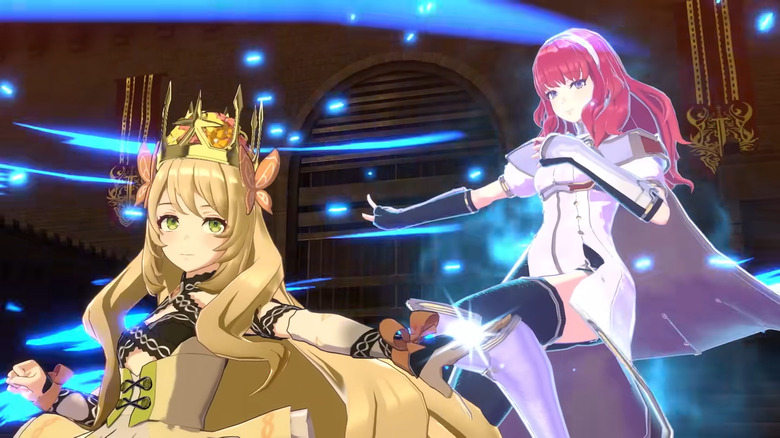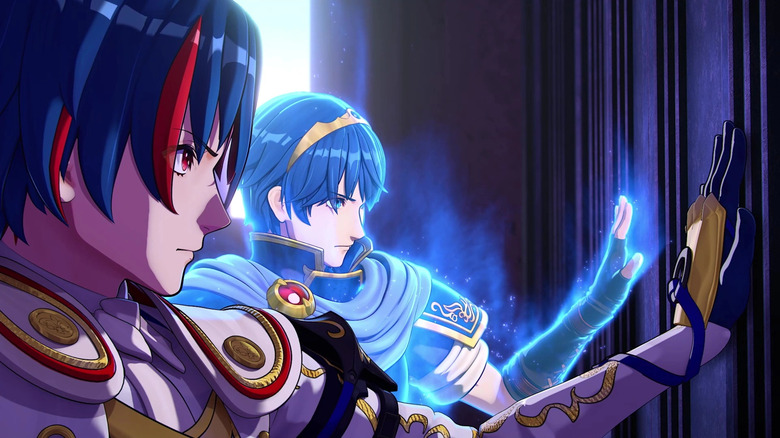How Emblem Rings Work In Fire Emblem Engage
Not many people would have expected to see a combination of Stands from "Jojo's Bizarre Adventure" and Magical Girl transformations making its way to a series like "Fire Emblem," but here we are: Serving as the game's signature combat mechanic, Emblem Rings in "Fire Emblem Engage" allow the player characters to summon and fuse with spirits of previous series icons like Marth and Lucina, bringing them into battle alongside the player character.
It might be a somewhat strange way of calling back to franchise history — especially considering "Engage" has no story connection to any previous games — but it introduces a compelling complexity to the class system. Though they don't affect the Growth Rates of class stats, any Emblem Ring can be equipped to any character and any class to provide additional, unique benefits.
However, it's worth noting that some character-emblem combinations are more synergistic than others, and it's important to understand the Emblem Rings' effects to fully utilize their potential. There are 12 Emblems in total, not counting the secret thirteenth Emblem or the DLC additions (per Serenes Forest). Here's a rundown on how Emblem Rings work in "Fire Emblem Engage."
How Engage mode works
As mentioned above, there are 12 base Emblem Rings that are awarded to the player at various points in the main story (per Fandom):
- Hero-King (Marth)
- Caring Princess (Celica)
- Holy Knight (Sigurd)
- Sage Lord (Leif)
- Young Lion (Roy)
- Lady of the Plains (Lyn)
- Azure Twins (Eirika and Ephraim)
- Radiant Hero (Ike)
- Dawn Maiden (Micaiah)
- Exalt Princess (Lucina)
- Crux of Fate (Corrin)
- Instructor (Byleth)
The central feature of Emblem Rings is the "Engage" state — when the Engage meter is full during combat, the character can perform a fusion with the Emblem and gain access to that Emblem's unique Engage Weapon and Engage Skills for three turns, after which the meter must be filled again before another Engage can be initiated. While this sounds rather restrictive, the Engage mode is more than worth it — with Engage Skills that range from being able to attack 7 times in one turn to being able to invite all allies within two spaces to chain attack on a single enemy, these three turns can be a complete tide-turner in any battle when used to their full potential.
Without unlocking any Bond Rank, every character has access to the Engage of any Emblem from the get-go upon equipping them, and there is no restriction on which character can access what abilities — magic-oriented characters will still get the powerful swords from Marth and Lucina's Engage while fighter-type characters will still be able to use magic from Emblems like Micaiah or Celica.
How Bond Ranks work
Another important aspect of using Emblems is long-term character growth. Using the Emblems will award more Bond points between that character and the Emblem, where higher Bond Ranks will unlock more and better abilities. Unlocking Bond Ranks is a simple matter of speaking to the Emblem at the Somniel once the required amount of points has been reached. There are 20 Ranks for each Emblem in total — and while every Emblem has unique features, there are a few universal rules across the board:
- Rank 5 allows a character to Inherit skills from the Emblem, allowing permanent access to them even without the ring equipped
- Ranks 10 awards a new and more powerful Engage Weapon, but is locked behind that Emblem's Paralogue (via Serenes Forest)
- Rank 20 unlocks Deep Engage, which shortens the Engage meter (per Gamespot)
You can gain Bond Ranks by either naturally accumulating points through use in battle, or by investing Bond Fragments — as Gamespot points out, training in the Arena between story missions awards Bond Points as readily as real battles do and can be an easy way to grind Emblem Bonds. Do note, however, that if you're too early in the game to unlock Emblem Paralogues, you'll be capped at Rank 10. Additionally, if any ring is taken from you due to events in the main story, you won't have access to their Paralogues until you regain them, even if you fulfill all other criteria.
How Emblem Skills work
However, there's more to Emblem Rings than the various benefits of the Engage state. There are four kinds of features that can be unlocked through Bond Ranks with an Emblem (per Serenes Forest):
- Inherited: Passive abilities that can be inherited in the Ring Chamber in exchange for Skill Points
- Sync: Passive abilities only active while Emblem is equipped, can be inherited after rank 5 at a much higher Skill Point cost than Inherited skills
- Engage: Passive and active abilities that are only useable while in the Engage mode in combat
- Unlock: Permanent Weapon Proficiency unlocks that will allow the character to promote into a wider variety of classes
As you can imagine, there's something to be said for pairing Emblems with characters of a similar skillset to boost their strengths and setting up non-synergistic pairs if only to widen the repertoire of said character. If you have the time and patience to do so, grinding Bond Ranks for the express purposes of inheriting and unlocking as many features as possible before switching to another Emblem can make a character extremely powerful in any role.
That said, if you don't have the extra patience for long grinds, it's probably better to invest in Emblem-character combinations you plan on keeping together for the most part. The choice is yours — what Emblem Rings really add to the tried-and-true tactical formula of "Fire Emblem" is greater flexibility in character builds, and by extension, individual playstyles.




